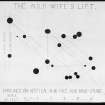Pricing Change
New pricing for orders of material from this site will come into place shortly. Charges for supply of digital images, digitisation on demand, prints and licensing will be altered.
Craigmaddie Muir, Auld Wives' Lifts
Carved Stone(S) (Period Unknown)
Site Name Craigmaddie Muir, Auld Wives' Lifts
Classification Carved Stone(S) (Period Unknown)
Canmore ID 44423
Site Number NS57NE 25
NGR NS 58184 76480
Datum OSGB36 - NGR
Permalink http://canmore.org.uk/site/44423
- Council East Dunbartonshire
- Parish Baldernock (Strathkelvin)
- Former Region Strathclyde
- Former District Strathkelvin
- Former County Stirlingshire
NS57NE 25 58185 76458
(NS 5818 7646) Auld Wives' Lifts (NR)
OS 6" map (1958)
See also NS57NE 21 and NS57SE 26.
The "Auld Wife's Lift" consists of two large boulders, standing close together, with a third lying on top of them. All three are of the local carboniferous sandstone and, although at first sight they might be thought to be a cromlech, their arrangement is unquestionably natural. A shallow incised groove, in the form of a circle 3ft in diameter, has been cut on the upper surface of the uppermost boulder, but it does not appear to have any archaeological significance, and may well have been made by a quarryman engaged on cutting out millstones nearby. (See NS57NE 21).
RCAHMS 1963, visited 1954
These stones are a natural formation.
Visited by OS (WMJ), 26 July 1951
(NS 5818 7646) Auld Wives' Lifts (NAT)
OS 1:10000 map (1976)
Alcock, who gives a full description of the heads, suggests that they may be of Celtic origin.
L Alcock 1977
Field Visit (November 1981)
'Auld Wives' Lifts', Craigmaddie Muir NS 581 764 NS57NE 25
The rock formation known as the Auld Wives' Lifts, which is situated on Craigmaddie Muir 400m N of North Blochairn farmhouse, comprises two massive earthfast blocks capped by a third. The surfaces of the blocks are covered with names and initials dating back to at least the early 19th century. There are also nine carved and incised heads of unknown date, and, on the flat top of the capstone, an incised circle 0.9m in diameter, the latter perhaps made by quarrymen cutting millstones.
RCAHMS 1982, visited November 1981
(RCAHMS 1963, p. 446, No. 576; Alcock 1977)






















